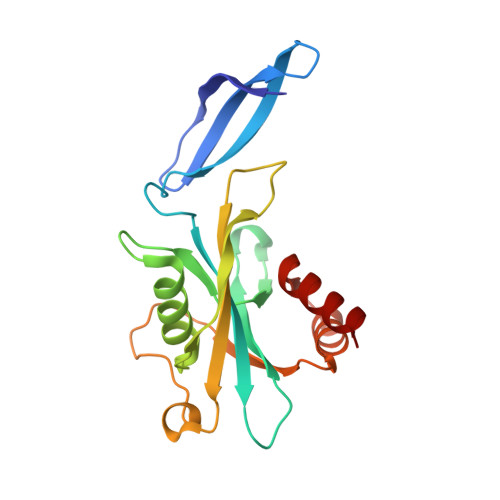Diverse substrate recognition and hydrolysis mechanisms of human NUDT5
Arimori, T., Tamaoki, H., Nakamura, T., Kamiya, H., Ikemizu, S., Takagi, Y., Ishibashi, T., Harashima, H., Sekiguchi, M., Yamagata, Y.(2011) Nucleic Acids Res 39: 8972-8983
- PubMed: 21768126
- DOI: https://doi.org/10.1093/nar/gkr575
- Primary Citation of Related Structures:
3AC9, 3ACA, 3L85 - PubMed Abstract:
Human NUDT5 (hNUDT5) hydrolyzes various modified nucleoside diphosphates including 8-oxo-dGDP, 8-oxo-dADP and ADP-ribose (ADPR). However, the structural basis of the broad substrate specificity remains unknown. Here, we report the crystal structures of hNUDT5 complexed with 8-oxo-dGDP and 8-oxo-dADP. These structures reveal an unusually different substrate-binding mode. In particular, the positions of two phosphates (α and β phosphates) of substrate in the 8-oxo-dGDP and 8-oxo-dADP complexes are completely inverted compared with those in the previously reported hNUDT5-ADPR complex structure. This result suggests that the nucleophilic substitution sites of the substrates involved in hydrolysis reactions differ despite the similarities in the chemical structures of the substrates and products. To clarify this hypothesis, we employed the isotope-labeling method and revealed that 8-oxo-dGDP is attacked by nucleophilic water at Pβ, whereas ADPR is attacked at Pα. This observation reveals that the broad substrate specificity of hNUDT5 is achieved by a diversity of not only substrate recognition, but also hydrolysis mechanisms and leads to a novel aspect that enzymes do not always catalyze the reaction of substrates with similar chemical structures by using the chemically equivalent reaction site.
Organizational Affiliation:
Graduate School of Pharmaceutical Sciences, Kumamoto University, Kumamoto 862-0973, Japan.
















